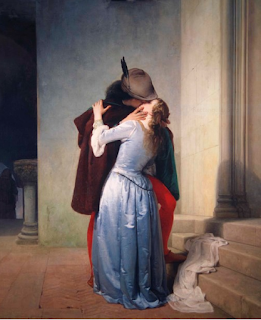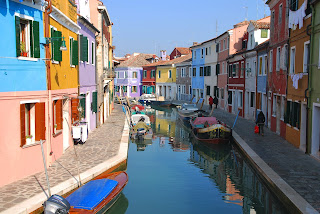Artist who pushed boundaries of sensuality
 |
| Francesco Hayez, as he appeared in an 1820s self-portrait |
His father, a fisherman, was French in origin and married a girl from Murano called Chiara Torcello, although they were a relatively poor family and Francesco was largely brought up by his wife’s sister, who had the good fortune to marry Giovanni Binasco, a wealthy ship-owner who dealt in antiques and collected art.
It was Binasco who fostered in Hayez his love of painting and after initially beginning an apprenticeship as an art restorer became a pupil in the studio of the Venetian painter Francesco Maggiotto. He was admitted to the New Academy of Fine Arts in Venice in 1806.
Hayez moved to Rome in 1809 after winning a one-year scholarship at the Accademia di San Luca. In the event, he stayed in Rome until 1814, then moved to Naples where he was commissioned by Joachim Murat, the French military commander and statesman who was King of Naples under Napoleonic rule, to paint a major work.
By the mid-1830s, Hayez had become interested in the growing Risorgimento movement, the proponents of which foresaw an Italy liberated from foreign control in which artistic expression could thrive. He moved to Milan, where he met like-minded painters and writers at the Salotto Maffei, the salon hosted by Clara Maffei, whose portrait Maffei's husband commissioned Hayez to paint.
 |
| Hayez's 1867 painting, The destruction of the Temple of Jerusalem |
Hayez’s output was substantial and varied throughout his career, from biblical themes to grand works depicting key contemporary political and social figures in settings from Italian history.
He had a particular penchant for paintings involving semi-clothed Odalisques, a favorite topic of Romantic painters. These women were female attendants in Turkish harems under Ottoman rule but the term came to mean a concubine in western usage, and their depiction in historical works allowed artists the ability to paint scenes that otherwise would not be deemed acceptable in 19th century society.
Later, Hayez focussed more and more on allegorical themes, often with strong patriotic or political connotations.
 |
| The allegorical painting, Il bacio, is seen by some as Hayez's finest work |
Il bacio is notable first for the passion with which the male figure kisses the woman, one hand at the back of her head while the other caresses her face, a sensual echo of his much earlier work, L'ultimo bacio di Romeo e Giulietta - The Last Kiss of Romeo and Juliet - painted in 1823, in Romeo’s hand on Juliet’s lower back, pulling her closer to him, was seen as somewhat risqué at the time.
It was seen as having a political message, too. Painted at a time when Milan and much of northern Italy was under the control of the Austrian Empire and the Habsburgs, Il bacio was interpreted as showing a young Italian soldier kissing goodbye to his lover before going off to fight for Italy against the Austro-Hungarians.
This was reinforced in a later version - Hayez is thought to have painted five versions in total - in which the red and green in the male figure’s costume, juxtaposed to a white shawl that has fallen on to some nearby steps, is seen to represent the Italian tricolore, and the blue and white of the woman’s clothing, next to the red of the man’s tights, is taken to represent the French flag, symbolising the alliance between Italy and France that ultimately brought about Italian unification.
Hayez was in demand also for his portraits, often commissioned by the nobility but also by his fellow artists and musicians. In the late stages of his career, he was known to have made use of photographs, sparing his subjects the need to pose for long periods.
He died in Milan in 1892 at the age of 91.
 |
| A canal in Murano, flanked by the examples of the island's characteristic coloured houses |
Murano, the home of Francesco Hayez’s mother, is a group of islands in the Venetian lagoon about a kilometre across the water from Venice’s northern shore. Like its neighbour, it has a network of canals. Historically a fishing port and a centre for salt production, nowadays it is famous for its multi-coloured houses and glass factories and attracts crowds of tourists, although this does not detract from its charm. The island is proud of its glass-making history, which can be studied at the Museo del Vetro, on Fondamenta Giustinian, but aggressive sales techniques and cheap imports masquerading as Murano glass have sullied its reputation in recent years.
Hotels in Murano by Booking.com
 |
| The Palazzo Brera is home to the Milan's renowned Accademia di Belle Arti |
The Accademia di Belle Arti di Brera, sometimes shortened to Accademia di Brera, where Francesco Hayez was the director, is now a state-run tertiary public academy of fine arts in Via Brera in Milan, in a building it shares with the Pinacoteca di Brera, Milan's main public museum for art, which houses the original version of Il bacio. The academy was founded in 1776 by Maria Theresa of Austria and shared its premises with other cultural and scientific institutions, including an astronomical observatory, botanical garden, school of philosophy and law, laboratories for physics and chemistry, and a library. The main building, the Palazzo Brera, was built in about 1615 to designs by Francesco Maria Richini.
Find a hotel in Milan with Booking.com
More reading:
How Giovanni Mazzini inspired the Risorgimento movement
Baldassare Verazzi, the painter who captured the Five Days of Milan uprising
The 18th century master of frescoes who became court painter to Napoleon
Also on this day:
1482: The death of sculptor Luca della Robbia
1821: The birth of painter Roberto Bompiani
1918: The death of Nobel Prize-winning peace activist Ernesto Teodoro Moneta
1944: The birth of writer and politician Raffaele Lauro
1953: The founding of oil and gas company ENI
1966: The birth of footballer Andrea Silenzi
(Paintings: Hayez's Self-Portrait in a Group of Friends (1824), Museo Poldi Pezzoli, Milan; The Destruction of The Temple of Jerusalem (1867), Gallerie dell'Accademia, Venice; Il bacio (1859), Pinacoteca di Brera, Milan)
(Picture credits: Palazzo Brera by MarkusMark via Wikimedia Commons)
No comments:
Post a Comment